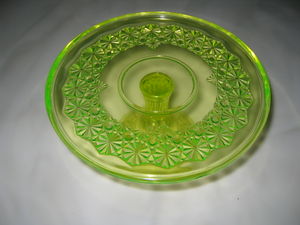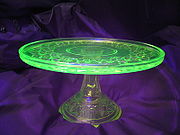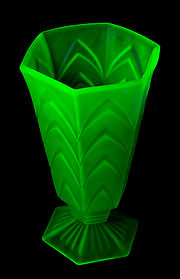
Uranium glass
Encyclopedia



Uranium
Uranium is a silvery-white metallic chemical element in the actinide series of the periodic table, with atomic number 92. It is assigned the chemical symbol U. A uranium atom has 92 protons and 92 electrons, of which 6 are valence electrons...
, usually in oxide diuranate form, added to a glass mix before melting. The proportion usually varies from trace levels to about 2% by weight uranium, although some 19th-century pieces were made with up to 25% uranium.
Uranium glass was once made into tableware and household items, but fell out of widespread use when the availability of uranium to most industries was sharply curtailed during the Cold War
Cold War
The Cold War was the continuing state from roughly 1946 to 1991 of political conflict, military tension, proxy wars, and economic competition between the Communist World—primarily the Soviet Union and its satellite states and allies—and the powers of the Western world, primarily the United States...
. Most such objects are now considered antiques or retro-era collectibles, although there has been a minor revival in art glassware. Otherwise, modern uranium glass is now mainly limited to small objects like beads or marbles
Marbles
A marble is a small spherical toy usually made from glass, clay, steel, or agate. These balls vary in size. Most commonly, they are about ½ inch in diameter, but they may range from less than ¼ inch to over 3 inches , while some art glass marbles fordisplay purposes are over 12 inches ...
as scientific or decorative novelties.
Appearance
The normal color of uranium glass ranges from yellow to green depending on the oxidation stateOxidation state
In chemistry, the oxidation state is an indicator of the degree of oxidation of an atom in a chemical compound. The formal oxidation state is the hypothetical charge that an atom would have if all bonds to atoms of different elements were 100% ionic. Oxidation states are typically represented by...
and concentration of the metal ions, although this may be altered by the addition of other elements as glass colorants. Uranium glass also fluoresces
Fluorescence
Fluorescence is the emission of light by a substance that has absorbed light or other electromagnetic radiation of a different wavelength. It is a form of luminescence. In most cases, emitted light has a longer wavelength, and therefore lower energy, than the absorbed radiation...
bright green under ultraviolet light and can register above background radiation on a sufficiently sensitive geiger counter
Geiger counter
A Geiger counter, also called a Geiger–Müller counter, is a type of particle detector that measures ionizing radiation. They detect the emission of nuclear radiation: alpha particles, beta particles or gamma rays. A Geiger counter detects radiation by ionization produced in a low-pressure gas in a...
, although most pieces of uranium glass are considered to be harmless and only negligibly radioactive.
Vaseline glass
The most typical color of uranium glass is pale yellowish-green, which in the 1920s led to the nickname vaselineVaseline
Vaseline is a brand of petroleum jelly based products owned by Anglo-Dutch company Unilever. Products include plain petroleum jelly and a selection of skin creams, soaps, lotions, cleansers, deodorants and personal lubricants....
glass based on a perceived resemblance to the appearance of petroleum jelly
Petroleum jelly
Petroleum jelly, petrolatum, white petrolatum or soft paraffin, CAS number 8009-03-8, is a semi-solid mixture of hydrocarbons , originally promoted as a topical ointment for its healing properties...
as formulated and commercially sold at that time. Specialized collectors still define "vaseline glass" as transparent or semitransparent uranium glass in this specific color.
"Vaseline glass" is now frequently used as a synonym for any uranium glass, especially in the United States, but this usage is not universal. The term is sometimes carelessly applied to other types of glass based on certain aspects of their superficial appearance in normal light, regardless of actual uranium content which requires a blacklight test to verify the characteristic green fluorescence.
In the United Kingdom
United Kingdom
The United Kingdom of Great Britain and Northern IrelandIn the United Kingdom and Dependencies, other languages have been officially recognised as legitimate autochthonous languages under the European Charter for Regional or Minority Languages...
and Australia
Australia
Australia , officially the Commonwealth of Australia, is a country in the Southern Hemisphere comprising the mainland of the Australian continent, the island of Tasmania, and numerous smaller islands in the Indian and Pacific Oceans. It is the world's sixth-largest country by total area...
, the term "vaseline glass" can be used to refer to any type of translucent glass. Even within the United States, the "vaseline" description is sometimes applied to any type of translucent glass with a greasy surface lustre
Lustre (mineralogy)
Lustre is a description of the way light interacts with the surface of a crystal, rock, or mineral. The word lustre traces its origins back to the Latin word lux, meaning "light", and generally implies radiance, gloss, or brilliance....
.
Other colors
Several other common subtypes of uranium glass have their own nicknames: custard glass (opaque or semiopaque pale yellow), jadite glass (opaque or semiopaque pale green; initially, the name was trademarked as "Jadite", although this is sometimes overcorrected in modern usage to "jadeiteJadeite
Jadeite is a pyroxene mineral with composition NaAlSi2O6. It is monoclinic. It has a Mohs hardness of about 6.5 to 7.0 depending on the composition. The mineral is dense, with a specific gravity of about 3.4. Jadeite forms solid solutions with other pyroxene endmembers such as augite and diopside ,...
"), and Depression glass (transparent or semitransparent pale green).
However, like "vaseline", the terms "custard" and "jad(e)ite" are often applied on the basis of superficial appearance rather than uranium content. Similarly, Depression glass
Depression glass
Depression glass is clear or colored translucent glassware that was distributed free, or at low cost, in the United States around the time of the Great Depression. The Quaker Oats Company, and other food manufacturers and distributors, put a piece of glassware in boxes of food, as an incentive to...
is also a general description for any piece of glassware manufactured during the Great Depression
Great Depression
The Great Depression was a severe worldwide economic depression in the decade preceding World War II. The timing of the Great Depression varied across nations, but in most countries it started in about 1929 and lasted until the late 1930s or early 1940s...
regardless of appearance or formula.
History

Pre-industrial usage
The use of uranium glass dates back to at least 79 AD, the date of a mosaicMosaic
Mosaic is the art of creating images with an assemblage of small pieces of colored glass, stone, or other materials. It may be a technique of decorative art, an aspect of interior decoration, or of cultural and spiritual significance as in a cathedral...
containing yellow glass with 1% uranium oxide
Uranium oxide
Uranium oxide is an oxide of the element uranium.The metal uranium forms several oxides:* Uranium dioxide or uranium oxide * Uranium trioxide or uranium oxide...
found in a Roman
Roman Empire
The Roman Empire was the post-Republican period of the ancient Roman civilization, characterised by an autocratic form of government and large territorial holdings in Europe and around the Mediterranean....
villa on Cape Posillipo
Posillipo
Posillipo is a residential quarter of Naples, southern Italy, located along the northern coast of the Gulf of Naples; it is called Pusilleco in the Neapolitan language.-Geography:...
in the Bay of Naples
Gulf of Naples
The Gulf of Naples is a c. 15 km wide gulf located in the south western coast of Italy, . It opens to the west into the Mediterranean Sea. It is bordered on the north by the cities of Naples and Pozzuoli, on the east by Mount Vesuvius, and on the south by the Sorrentine Peninsula and the main...
, Italy
Italy
Italy , officially the Italian Republic languages]] under the European Charter for Regional or Minority Languages. In each of these, Italy's official name is as follows:;;;;;;;;), is a unitary parliamentary republic in South-Central Europe. To the north it borders France, Switzerland, Austria and...
by R. T. Gunther of the University of Oxford
University of Oxford
The University of Oxford is a university located in Oxford, United Kingdom. It is the second-oldest surviving university in the world and the oldest in the English-speaking world. Although its exact date of foundation is unclear, there is evidence of teaching as far back as 1096...
in 1912. Starting in the late Middle Ages
Middle Ages
The Middle Ages is a periodization of European history from the 5th century to the 15th century. The Middle Ages follows the fall of the Western Roman Empire in 476 and precedes the Early Modern Era. It is the middle period of a three-period division of Western history: Classic, Medieval and Modern...
, pitchblende
Uraninite
Uraninite is a radioactive, uranium-rich mineral and ore with a chemical composition that is largely UO2, but also contains UO3 and oxides of lead, thorium, and rare earth elements...
was extracted from the Habsburg
Habsburg
The House of Habsburg , also found as Hapsburg, and also known as House of Austria is one of the most important royal houses of Europe and is best known for being an origin of all of the formally elected Holy Roman Emperors between 1438 and 1740, as well as rulers of the Austrian Empire and...
silver
Silver
Silver is a metallic chemical element with the chemical symbol Ag and atomic number 47. A soft, white, lustrous transition metal, it has the highest electrical conductivity of any element and the highest thermal conductivity of any metal...
mines in Joachimsthal
Jáchymov
For other places called Joachimsthal, see Joachimsthal Jáchymov . compl: "Sant Joachim's Sthal" is a spa town in north-west Bohemia in the Czech Republic belonging to the Karlovy Vary Region. It is situated at an altitude of 733 m above sea level in the eponymous St...
, Bohemia
Bohemia
Bohemia is a historical region in central Europe, occupying the western two-thirds of the traditional Czech Lands. It is located in the contemporary Czech Republic with its capital in Prague...
(now Jáchymov in the Czech Republic
Czech Republic
The Czech Republic is a landlocked country in Central Europe. The country is bordered by Poland to the northeast, Slovakia to the east, Austria to the south, and Germany to the west and northwest....
) and was used as a coloring agent in the local glass
Glass
Glass is an amorphous solid material. Glasses are typically brittle and optically transparent.The most familiar type of glass, used for centuries in windows and drinking vessels, is soda-lime glass, composed of about 75% silica plus Na2O, CaO, and several minor additives...
making industry.
Martin Klaproth (1743–1817), the discoverer of uranium, later experimented with the use of this element
Chemical element
A chemical element is a pure chemical substance consisting of one type of atom distinguished by its atomic number, which is the number of protons in its nucleus. Familiar examples of elements include carbon, oxygen, aluminum, iron, copper, gold, mercury, and lead.As of November 2011, 118 elements...
as a glass colorant.
Modern production
Uranium glass became popular in the mid 19th century, with its period of greatest popularity being from the 1880s to the 1920s.The first major producer of items made of uranium glass is commonly recognized as German Josef Riedel, who named the yellow and yellow-green (German: Gelb-Grün) varieties of the glass "annagelb" and "annagrün", respectively, in honor of his wife Anna Maria. Riedel was a prolific blower of uranium glass in Unter-Polaun (today Dolni Polubny), Bohemia
Bohemia
Bohemia is a historical region in central Europe, occupying the western two-thirds of the traditional Czech Lands. It is located in the contemporary Czech Republic with its capital in Prague...
from 1830 to 1848.
By the 1840s, many other Europe
Europe
Europe is, by convention, one of the world's seven continents. Comprising the westernmost peninsula of Eurasia, Europe is generally 'divided' from Asia to its east by the watershed divides of the Ural and Caucasus Mountains, the Ural River, the Caspian and Black Seas, and the waterways connecting...
an glassworks began to produce uranium glass items and developed new varieties of uranium glass. The Baccarat glassworks of France
France
The French Republic , The French Republic , The French Republic , (commonly known as France , is a unitary semi-presidential republic in Western Europe with several overseas territories and islands located on other continents and in the Indian, Pacific, and Atlantic oceans. Metropolitan France...
created an opaque green uranium glass which they named chrysoprase
Chrysoprase
Chrysoprase, chrysophrase or chrysoprasus is a gemstone variety of chalcedony that contains small quantities of nickel. Its color is normally apple-green, but varies to deep green. The darker varieties of chrysoprase are also referred to as prase...
from its similarity to that green form of chalcedony
Chalcedony
Chalcedony is a cryptocrystalline form of silica, composed of very fine intergrowths of the minerals quartz and moganite. These are both silica minerals, but they differ in that quartz has a trigonal crystal structure, while moganite is monoclinic...
.
At the end of the 19th century, glassmakers discovered that uranium glass with certain mineral additions could be tempered at high temperatures, inducing varying degrees of microcrystallization. This produced a range of increasingly opaque
Opacity (optics)
Opacity is the measure of impenetrability to electromagnetic or other kinds of radiation, especially visible light. In radiative transfer, it describes the absorption and scattering of radiation in a medium, such as a plasma, dielectric, shielding material, glass, etc...
glasses from the traditional transparent yellow or yellow-green to an opaque white. During the Depression years, more iron oxide was added to the mixture to match popular preferences for a greener glass. This material, technically a glass-ceramic
Glass-ceramic
Glass-ceramics are polycrystalline material produced through controlled crystallization of base glass. Glass-ceramic materials share many properties with both glasses and ceramics...
, acquired the name "vaseline glass" because of its supposedly similar appearance to petroleum jelly
Petroleum jelly
Petroleum jelly, petrolatum, white petrolatum or soft paraffin, CAS number 8009-03-8, is a semi-solid mixture of hydrocarbons , originally promoted as a topical ointment for its healing properties...
. Today, a few manufacturers continue the vaseline glass tradition: Fenton Glass, Mosser Glass, Gibson Glass and Jack Loranger.
US production of uranium glasses ceased in the middle years of World War II because of the US government's confiscation of uranium supplies, and did not resume until 1958.
Riihimäki Glass
Riihimaki glass
Riihimäki glass was a reputed glass company in Riihimäki, Finland, in operation from 1910, when it was founded by Mikko Adolf Kolehmainen, to 1990. Their production ranged from basic to high quality glass ornaments, which are now sought after as collectibles, especially some of their vases...
produced uranium glass designer pieces after World War II.

